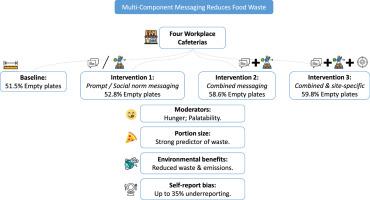消息传递的协同作用:多组件方法减少了德国自助餐厅的食物浪费
IF 10.9
1区 环境科学与生态学
Q1 ENGINEERING, ENVIRONMENTAL
引用次数: 0
摘要
减少工作场所食堂食物浪费的努力正在增加,但信息干预的效果尚不清楚。我们在四家德国自助餐厅测试了三个为期一周的消息传递活动——提示消息、社会规范消息和联合创建的针对特定站点的定制消息。对2361名用餐者近4万份盘子观察和调查的分析表明,只有联合干预才能显著减少盘子浪费;单独的提示和规范消息都没有产生有意义的影响。针对个别站点定制信息并没有带来额外的好处,这表明结构因素——尤其是份量大小——主导了浪费的结果。食客们也倾向于少报剩饭剩菜,这凸显了自我报告中的认知偏见。通过将客观观察与调查数据相结合,我们的研究结果强调需要采用协同的多组分方法,将份量控制和菜单设计与引人入胜的协调策略相结合,以大幅减少食物浪费。本文章由计算机程序翻译,如有差异,请以英文原文为准。

Synergy in messaging: A multi-component approach reduces food Waste in German cafeterias
Efforts to reduce food waste in workplace cafeterias are increasing, but the effect of informational interventions remains unclear. We tested three one-week messaging campaigns—prompt messaging, social norm messaging, and a combined message with co-created site-specific tailoring—across four German cafeterias. Analyses of nearly 40,000 tray observations and surveys from 2361 diners showed that only the combined intervention significantly reduced plate waste; neither prompt nor norm messages alone had a meaningful impact. Tailoring messages to individual sites provided no additional benefit, indicating that structural factors—particularly portion size—dominate waste outcomes. Diners also tended to underreport small leftovers, highlighting cognitive biases in self-reporting. By combining objective observations with survey data, our findings emphasise the need for synergistic, multi-component approaches that pair portion control and menu design with engaging, coordinated strategies to substantially cut food waste.
求助全文
通过发布文献求助,成功后即可免费获取论文全文。
去求助
来源期刊

Resources Conservation and Recycling
环境科学-工程:环境
CiteScore
22.90
自引率
6.10%
发文量
625
审稿时长
23 days
期刊介绍:
The journal Resources, Conservation & Recycling welcomes contributions from research, which consider sustainable management and conservation of resources. The journal prioritizes understanding the transformation processes crucial for transitioning toward more sustainable production and consumption systems. It highlights technological, economic, institutional, and policy aspects related to specific resource management practices such as conservation, recycling, and resource substitution, as well as broader strategies like improving resource productivity and restructuring production and consumption patterns.
Contributions may address regional, national, or international scales and can range from individual resources or technologies to entire sectors or systems. Authors are encouraged to explore scientific and methodological issues alongside practical, environmental, and economic implications. However, manuscripts focusing solely on laboratory experiments without discussing their broader implications will not be considered for publication in the journal.
 求助内容:
求助内容: 应助结果提醒方式:
应助结果提醒方式:


